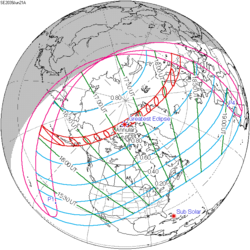| Partial eclipse | |
| Gamma | 1.0447 |
|---|---|
| Magnitude | 0.8874 |
| Maximum eclipse | |
| Coordinates | 69°30′N1°00′E / 69.5°N 1°E |
| Times (UTC) | |
| Greatest eclipse | 13:30:53 |
| References | |
| Saros | 153 (11 of 70) |
| Catalog # (SE5000) | 9620 |
A partial solar eclipse will occur at the Moon's ascending node of orbit on Monday, November 14, 2050, [1] with a magnitude of 0.8874. A solar eclipse occurs when the Moon passes between Earth and the Sun, thereby totally or partly obscuring the image of the Sun for a viewer on Earth. A partial solar eclipse occurs in the polar regions of the Earth when the center of the Moon's shadow misses the Earth.
Contents
- Eclipse timing
- Places experiencing partial eclipse
- Eclipse details
- Eclipse season
- Related eclipses
- Eclipses in 2050
- Metonic
- Tzolkinex
- Half-Saros
- Tritos
- Solar Saros 153
- Inex
- Triad
- Solar eclipses of 2047–2050
- Saros 153
- Metonic series
- Tritos series
- Inex series
- References
- External links
The partial solar eclipse will be visible for parts of the Northeastern United States, eastern Canada, Greenland, Europe, West Africa, and North Africa.


























































































